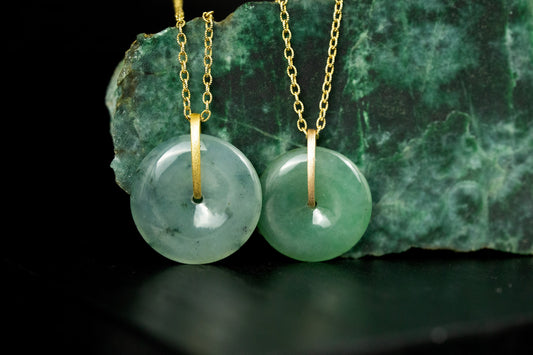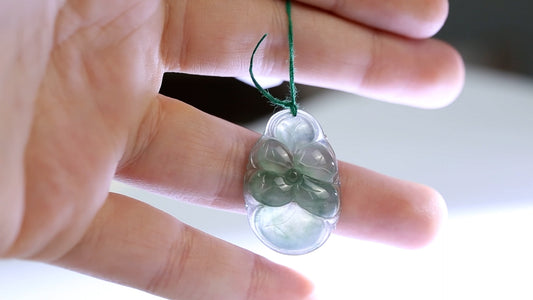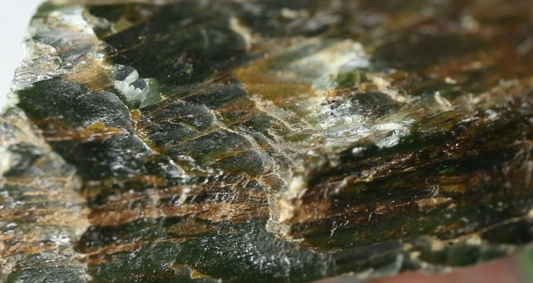This article has been a long time coming. Please understand that my views do not represent the views of Mason-Kay Jade, any of their retail partners, or any JOTT Marketing client.
In November of 2023, I dropped the above video on my YouTube channel, Jewels of the Trade, where I interviewed Lotus Gemology's Richard Hughes and Kaylin Khourie about what I call The Omphacite Dilemma.
A lot has changed since this video came out.
Unbeknownst to me at the time, GIA would announce one month later that they were adding the term fei cui to the comments section of all of their jade reports in a statement saying "The term 'Fei Cui' refers to jadeite, omphacite, and kosmochlor"
(There was no connection between this video and GIA's announcement. In preparation for the video, I had called GIA to interview them and they insinuated they had a big announcement coming soon -- I just didn't know how soon.)
Fast forward to today. Are customers saying "fei cui?" Are American sellers saying "fei cui?" I'll admit, the video sparked quite a bit of controversy in the jade world and it's been a bit of a sensitive subject for some jade sellers until now.
Let me start from the beginning and catch you up to speed on how the jade market uses the term "fei cui" in 2025.
A History of Jade's Problematic Nomenclature
I don't want to spoil Lotus Gemology's book Broken Bangle: The Blunder-Besmirched History of Jade Nomenclature for you. It's a pretty technical read that debunks common myths about the history of jade terms such as jadeite and nephrite. It has been my observation that members of the trade who take issue with the word "fei cui" (and yes, there are many) have not read this book. More on this topic in a later section of this article.
A quick note: Please understand that opinions surrounding the term "fei cui" are just that, opinions. Disagreement over the term is important to the trade, but pedantic to the customer. An opinion on either side of the fei cui argument says nothing about the authenticity of a jade sellers product, the fairness of their pricing, or their knowledge as a jade professional. As fun and dramatic as the nomenclature debate is, I wouldn't want a seller to ever lose a sale over it. |
Jade is an English word and a trade term at best. Jade is not a mineral, and it's not a technical term. In the USA, we reserve the term (at an academic level, in this case, in the field of what we call "gemology" -- a science based on geology that has been adapted for the consumer) for only jadeite jade (also called fei cui) and nephrite jade.
However, as many experienced jade shoppers know, Chinese sellers use this term liberally -- as it has less of a scientific connotation in the East, where gemstones are categorized by their cultural significance and symbolism more than their chemical composition and crystal structure. Chinese jade sellers may use the term jade to refer to jadeite jade, nephrite jade, serpentine, grossular garnet, dyed green quartz, and an array of other gemstones. Perhaps some of their motivations are unscrupulous, but for some, it may have more to do with how they use the word jade to mean "beautiful stone" or "carving stone."
So that's one problem.
Then you have nephrite jade, which you think would be a mineral -- but it's not.
Nephrite Jade is a gemstone comprised of the minerals in the actinolite-tremolite solid solution series. Actinolite and tremolite are end-member minerals (finally! Something that's actually a mineral!), but they are only considered nephrite jade when microcrystalline. And confusingly, even some microcrystalline actinolite is not considered nephrite jade -- for reasons I'm still trying to understand myself.
But the topic of this article is not nephrite jade, it's more complicated than that.
The other piece of our jade nomenclature problem is the term jadeite jade, which you think would be a mineral -- but, alas, it's not...
Jadeite is a mineral. But the gemstone sold as jadeite jade (also called fei cui) is not monocrystalline jadeite, it's a polycrystalline aggregate -- meaning a rock comprised of many microscopic minerals.
A mix of microscopic crystals where jadeite is the primary mineral.
...Except for when jadeite is not the primary mineral.
Jadeite Jade sans Jadeite
I know this is dry, but stay with me.
The terms jade and jadeite pre-date the advanced equipment that has been used in recent decades to determine the composition of a jade stone. Even when French mineralogist Alexis Damour coined the term jadeite in the 1800's, he did not know that the gemstone in his hands that had been looted from the Summer Palace in Peking was a polycrystalline aggregate. Due to limitations in technology at the time, he simply thought the whole stone was one mineral.
Now, scientists know that a jade stone is comprised of an array of minerals -- albite, diopside, hedenbergite, aegerine, vesuvianite, pumpellyite, and many more. In geology, the polycrystalline aggregate that may have any one or combination of these minerals where jadeite is the primary mineral (comprising the vast majority of the stone) is called jadeitite (pronounced jade-ih-tight). Jadeitite is not a gemological term, meaning it's not used by gemological laboratories, jewelry appraisers, or jewelry stores. The gemological equivalent of jadeitite is jadeite jade.
So what's the problem?
Well, come to find out...There are fine gemstones with similar properties and appearances as jade that are not comprised primarily of jadeite -- but rather the chemically very (very!) similar minerals omphacite and kosmochlor.
In geology, a rock that is primarily comprised of omphacite may be called omphacicite.
And a rock comprised primarily of kosmochlor may be called kosmochlorite.
But a gemstone is a small piece of that boulder, and to the world -- it's simply called jade.
Are jadeite and omphacite different?
To scientists, yes. But in ways that effect the jewelry customer, no.
Omphacite and kosmochlor are green to black, but jadeite is allochromatic -- meaning it's colorless unless colored by it's trace elements.
Jadeite's chemical composition is NaAlSi2O6. When chromium substitutes for aluminum, jadeite becomes green. Interestingly enough, kosmochlor is NaCrSi2O6. See what I mean when I say they're chemically very similar? When they're mixed, distinguishing them may even come down to a judgement call.
As for omphacite, which is the word that started this international controversy, the chemical composition is also very similar -- except that omphacite can have more variation, and aluminum is replaced by iron to create a green color.
Some of the finest imperal jade in the world is primarily comprised of omphacite.
Omphacite. A silly name for a mineral (not a gemstone) that no one has ever heard of.
As you continue reading this article, I hope you'll see that the field of gemology -- a semi-science made to be palatable to the consumer -- has fallen victim to highly-technical geochemical jargon that customers simply don't care about.
Can't gemologists just identify omphacite by testing it?
You'd think, wouldn't you?
If GIA is willing to sound the alarms (see The Jadeite-Omphacite Nomenclature Question, GIA, April 10, 2012) and send the jade trade into a tizzy over the distinction between jadeite and omphacite -- then there must be a reliable way to distinguish a jade stone that is primarily jadeite from one that is primarily omphacite.
And this is the core of the fei cui argument. Right here.
Some gemologists claim they can identify a jade stone that is primarily omphacite, using surface testing methods such as spectroscopy.
But Lotus Gemology has declared that it's only possible to conclusively identify omphacite jade through destructive testing.
If you want to really understand this, I refer you to Kaylin Khourie -- who is much smarter than I am, and who wrote the article The Hardness of Fei Cui Jade: A Gemological Perspective.
Here's the gist: Complex intermixing of omphacite, jadeite, and kosmochlor lends surface testing towards incomplete results. For instance, if the laser on the spectrometer reads the spectra on one grain in a jade stone -- and that grain is omphacite, does that mean the whole jade stone is omphacite? Of course not. All gemologists agree that more data is needed.
...So how many times do you test it?
Two more times? Three more times? As of 2023, GIA told me they would test the surface of a jade stone 3 times, sometimes 4 before making a call as to whether a jade stone was jadeite or omphacite.
If a gemologist is being thorough, it might take 2 or 3 days to map the surface of the jade stone using a variable pressure scanning electron miscroscope (VPSEM) -- which by the way, no jewelry store has. Even most gemologist appraisers don't have an electron microscope or the know-how to use one. But then what? It's still only the surface, and there is no way to test the individual crystals beneath the surface with a RAMAN spectrometer or an electron microscope. To know exactly how much omphacite is in a jade stone (thereby determining whether omphacite or jadeite is the primary mineral), a section of the stone would have to be crushed into a powder for X-ray diffraction.
Frankly, I feel I've explained this the best way I can as a layman.
For a more technical explanation, please refer to Dr. Edward Liu's presentation "Jadeite Jade or Fei Cui?"
The Need for an Umbrella Term
The takeaway is this: At this time, there is no practical, affordable, non-destructive method for the trade to evaluate whether a customers jade stone is primarily jadeite versus primarily omphacite.
So whether it's mineralogy is primarily jadeite, omphacite, or kosmochlor -- it needs to be classified as the same gemstone.
We need an umbrella term, something that encompasses jade stones that are primarily jadeite, omphacite, or kosmochlor -- or a combination of the three.
...But what will it be?
Enter Fei Cui
It's estimated that 96% of the world's jewelry market is in China. To keep things simple, some might suggest we call jade what they call jade.
China uses the term 和田玉 to refer to nephrite jade, and 翡翠 to refer to what we call jadeite jade.
Their word for jadeite jade, 翡翠, is pronounced "fay choy" and romanized as "fei cui."
If we use the term fei cui, we're not coming up with a new name for jade -- we're using the most common term for jadeite jade in the world. The downside? In my opinion, there is none. Not only are customers already using this term thanks to Chinese sellers on TikTok, but Lotus Gemology's Richard Hughes has been educating the American trade on the use of this word as well for at least two years. Even since my YouTube video on the topic dropped, I've heard more people in the US trade saying "fei cui."
It is my opinion that the fei cui train has already taken off. It may be a long transition period, but eventually, jade customers will call jadeite jade "fei cui."
The End?
Lol no.
Western use of the term fei cui has been met with mountains of scrutiny. Their perspective is that an umbrella term is unnecessary (not true,) that fei cui isn't actually being used (also not true), and that it's hard to pronounce. I guess these folks weren't consulted on gem names such as Paraiba tourmaline, sphene, and peridot. But then again, those words aren't Chinese.
Let me make an argument for their case though, and this is truly my opinion: There is absolutely no reason for jade sellers in Latin American countries to use the term "fei cui" if they don't want to. For instance, Guatemalan jadeite jade sellers based in Guatemala and Mexico.
Do you know what sellers call jadeite jade in Guatemala? They call it jade. (Pronounced hah-day)
Distinguishing between jadeite jade and nephrite jade is less important in Latin American countries because there is almost no nephrite jade to speak of there. When they buy jade, it's jadeite jade.
Additionally, the Spanish language is simply not as scientific as English. Like the Chinese, the Guatemalan and Mexican people care about jade because of it's culture and history -- in their case, from the Aztecs and Maya which have so significantly influenced their modern-day culture.
Spanish speakers don't need to confuse their customers with a third language -- they want to connect customers to jade culture. If we could do this too (and we can't), if we could go back to a simple term that expresses jade's meaning, I would favor that. I'd simplify jade nomenclature in a heartbeat if we could distill it down to a few words with real meaning.
But that's not the option available for us in America.
The reality is, we've accumulated words like jadeite, nephrite, tremolite, Hetian jade, fei cui, pyroxene jade, amphibole jade, omphacite, and kosmochlor and we've pushed them out into the market before understanding what they mean.
Let's not make this mistake again.
Let's use words that have meaning, let's communicate clearly with our customers.
I don't see how the jade industry can grow in the USA without at least that.
 |
Jordan Wentz is an independent sales representative and digital marketing specialist with 12 years of experience in the fine jewelry industry. Known for her role as wholesale sales rep for the leading supplier of natural jadeite jade in the USA, Mason-Kay Jade, she has gained notoriety as an educational content creator for her YouTube channel Jewels of the Trade which gets 60k-100k views per month and is targeted towards jewelry customers to help them connect with trustworthy jewelry sellers. Jordan is also the Conference Director for the International Jade Summit, a professional jade conference that takes place at the Monterey Bay Jade Festival. |





